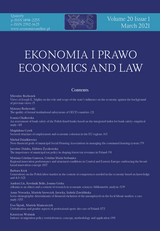Indexes of migration policy restrictiveness: concept, methodology and application
Indexes of migration policy restrictiveness: concept, methodology and application
Author(s): Katarzyna WoźniakSubject(s): Labor relations, Methodology and research technology, Migration Studies, Asylum, Refugees, Migration as Policy-fields
Published by: Wydawnictwo Naukowe Uniwersytetu Mikołaja Kopernika
Keywords: international economics; immigration policy; migration policy; migration policy indexes;
Summary/Abstract: Motivation: migration management has become important both in the political debate and academic research. In recent years the interest of researchers in migration policy has significantly increased. As a result, there have been many quantitative studies related to the migration policy. Aim: the aim of this paper is to conduct a comparative analysis of the migration policy indexes (including databases on migration policies), as well as to broaden the understanding of the scope and essence of migration policies. Results: The indexes of migration (including immigration) restrictiveness are based on various concept of this policy. However, all the indexes of migration (including immigration) restrictiveness are based on de jure migration laws and regulations measures adopted by states (on the national level). The most of indexes of migration (including immigration) policy restrictiveness are based on a set of coded questions relating to these policies. An important factor differencing the migration policy indexes is also the fact that in some analyses relative changes of migration policy were evaluated, but in other studies absolute changes were considered. Concerning to the indexes of immigration restrictiveness, most of them are based on entry and stay regulations. The possible application of indexes in other studies is especially related to the time and geographical scope of these indexes, as well as to their level of detail. Most of the data on migration policies is available mainly for the developed countries, the majority of which belongs to the OECD or the European Union. Some of them allow for the long-term analysis and other for short-term study. For most countries the data is available since the 1980s. Additionally, some of indexes on immigration policy restrictiveness are characterised by relative higher level of detail of the analysis and results are classified for various groups of migrants and type of migration.
Journal: Ekonomia i Prawo. Economics and Law
- Issue Year: 20/2021
- Issue No: 1
- Page Range: 191-207
- Page Count: 18
- Language: English

